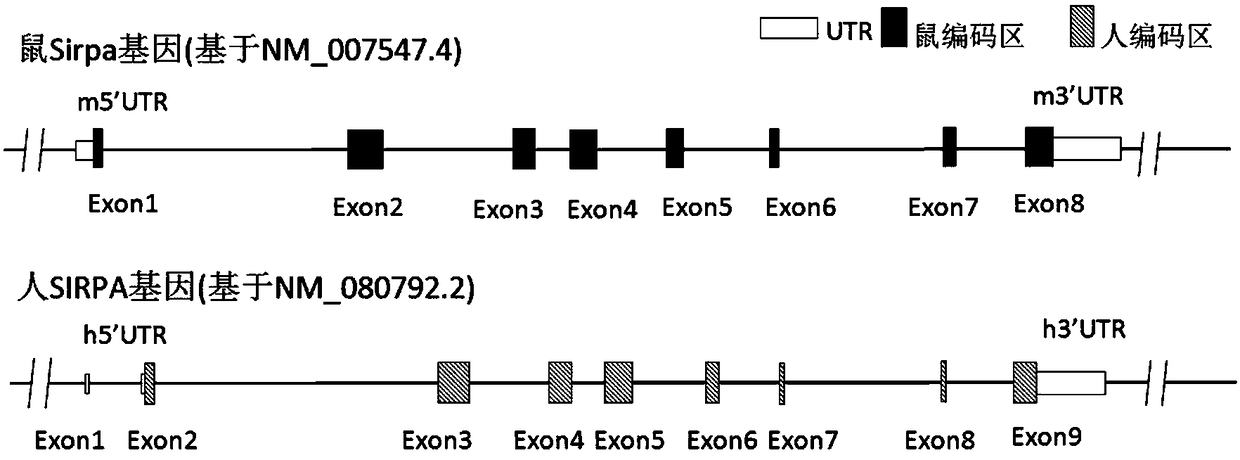Preparation method and application of humanized SIRPA genetically modified animal model
An animal model and humanized technology, applied in botany equipment and methods, biochemical equipment and methods, plant gene improvement, etc., can solve problems such as the complexity of genetic factors, reduce the risk of drug development, and speed up the research and development process , saving time and cost
- Summary
- Abstract
- Description
- Claims
- Application Information
AI Technical Summary
Problems solved by technology
Method used
Image
Examples
Embodiment 1
[0209] Embodiment 1 sequence design
[0210] Non-human animals, such as the mouse Sirpa gene and the human SIRPA gene both contain multiple transcripts, and the sequence design of this embodiment is mainly described using one of the transcripts as an example. That is, the main part of exon No. 2 of the mouse Sirpa gene (Gene ID: 19261) (based on the transcript whose NCBI accession number is NM_007547.4 → NP_031573.2, its mRNA sequence is shown in SEQ ID NO: 1, The corresponding protein sequence is shown in SEQ ID NO: 2) with the corresponding fragment replacement of human SIRPA gene (Gene ID: 140885) (based on the transcript of NM_080792.2 → NP_542970.1 whose NCBI accession number is, its mRNA sequence is shown in SEQ ID NO : shown in 3, and the corresponding protein sequence is shown in SEQ ID NO: 4), wherein, the comparative schematic diagram of mouse Sirpa and human SIRPA gene is shown in figure 1 , the schematic diagram of the finally obtained transformed humanized mouse ...
Embodiment 2
[0216] Design and construction of embodiment 2 vector pClon-4G-SIRPA
[0217] According to the sequence design, the inventor has further designed such as image 3 The targeting scheme and the vector containing the 5' homology arm, the human SIRPA gene fragment, and the 3' homology arm are shown. Wherein the 5' homology arm (SEQ ID NO: 29) is 129607346-129608914 nucleotides of NCBI accession number NC_000068.7, and the 3' homology arm (SEQ ID NO: 30) is NCBI accession number NC_000068. 129609239-129610638 nucleotides of 7, and the human SIRPA (SEQ ID NO: 31) gene fragment is 1915110-1915433 nucleotides of NCBI accession number NC_000020.11.
[0218] The construction process of the vector is as follows: design the upstream primers for amplifying three homologous recombination fragments (LR, A, RR), the matching downstream primers and related sequences. Among them, the 5' homology arm corresponds to the LR segment, the human SIRPA gene segment corresponds to the A segment, and ...
Embodiment 3
[0229] Example 3 Verification of carrier pClon-4G-SIRPA
[0230] Randomly select 3 pClon-4G-SIRPA clones, and use 2 kinds of restriction endonucleases for enzyme digestion verification. Among them, EcoRI should appear 1371bp+5439bp, and BamHI should appear 52bp+321bp+900bp+5537bp. For enzyme digestion results, see Figure 4 , the digestion results of plasmids numbered 1, 2, and 3 were all in line with expectations, indicating that the verification results of plasmid digestion were correct. Plasmids 1 and 2 were verified to be correct by the sequencing company, and plasmid 2 was selected for subsequent experiments.
PUM
 Login to View More
Login to View More Abstract
Description
Claims
Application Information
 Login to View More
Login to View More - R&D
- Intellectual Property
- Life Sciences
- Materials
- Tech Scout
- Unparalleled Data Quality
- Higher Quality Content
- 60% Fewer Hallucinations
Browse by: Latest US Patents, China's latest patents, Technical Efficacy Thesaurus, Application Domain, Technology Topic, Popular Technical Reports.
© 2025 PatSnap. All rights reserved.Legal|Privacy policy|Modern Slavery Act Transparency Statement|Sitemap|About US| Contact US: help@patsnap.com



